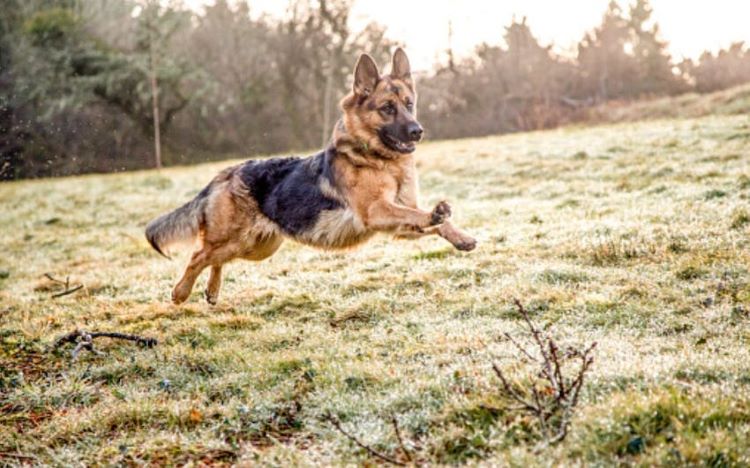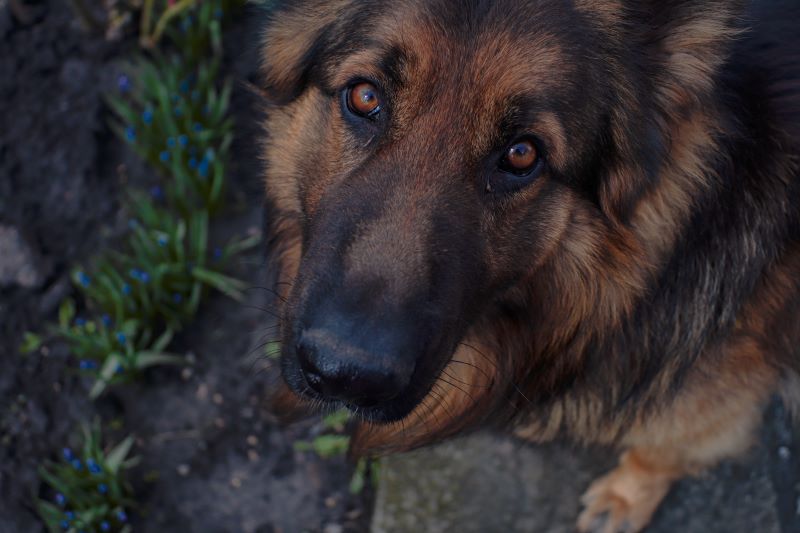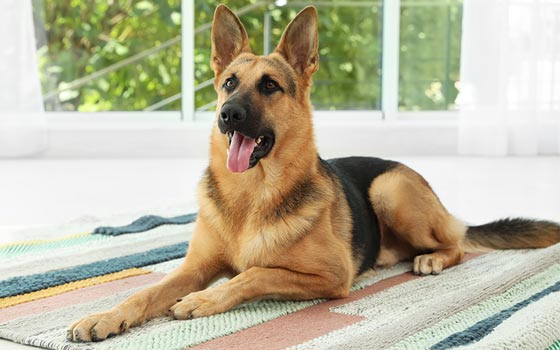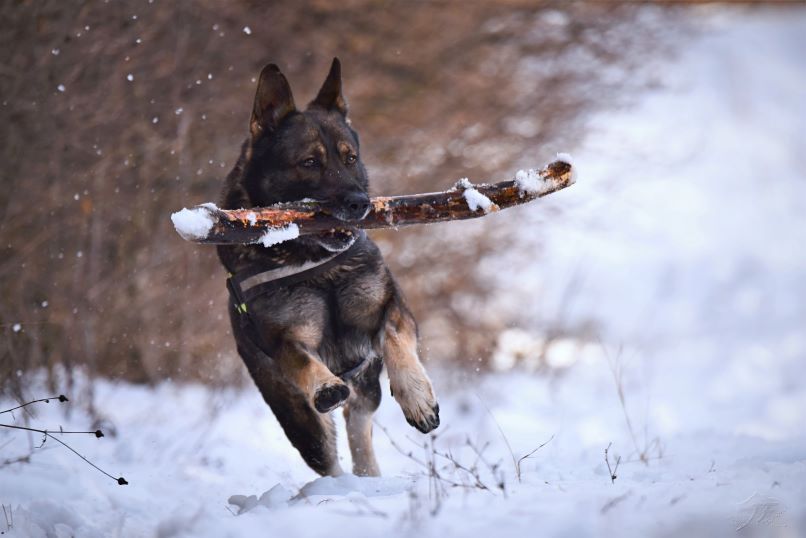Ready to help treat your pet to a healthy life?
German Shepherd Dog Breed Guide
By : Trupanion Staff | Updated Feb 14, 2024

Even if you've never had one in your family, you are probably familiar with the German Shepherd. These impressive canines are recognizable across society thanks to their prevalence as working dogs. German Shepherds are highly intelligent, and they have fulfilled a variety of roles as police, guide, and search-and-rescue dogs. Their regal stature and intensity can make them appear intimidating, however, and they can be wary of strangers. These canines are naturally protective, but can make safe, loving family pets if they are exposed to different people and animals at a young age.
Fun facts about German Shepherds
- German Shepherds are large, athletic dogs, with males weighing between 65 and 90 lbs. when fully grown and females weighing between 50 and 75 lbs.
- The dog sport of Schutzhund (which combines tracking, obedience, and protection work) was developed specifically to test the instincts and physical ability of the German Shepherd Dog breed. While other breeds can compete in this sport, the majority of participants are German Shepherds.
- During World War I, the AKC dropped “German” from the breed name, referring to German Shepherds as Shepherd Dogs for a couple of decades. In Britain, they changed the name altogether, renaming it the Alsatian Shepherd. It wasn’t until 1977 that the British breed club officially re-recognized German Shepherd Dog as the official breed name.
- Most commonly recognized for their black and tan coloring, there are actually quite a variety of colors within the breed - even what’s called a “panda” German Shepherd which has a piebald coat (white, black, and tan) caused by a rare genetic mutation.
- The first-ever guide dog for the visually impaired was a female German Shepherd Dog named Buddy. She worked as Morris Frank’s guide dog from 1928 until she died ten years later. Frank co-founded The Seeing Eye, the first guide-dog school in the United States.
- The German Shepherd is one of the most popular dog breeds used as police or military working dogs. While this often encourages the stereotype that the breed is aggressive, GSDs perform well in these roles because they are highly trainable, loyal, and have a strong desire to work. In fact, dogs that exhibit actual aggression in these lines of work are often disqualified from the training program.
- A German Shepherd named Arrow worked in South Africa with his handler to thwart wildlife poachers, along with other dogs from the same training academy. In 2016, he earned the Guinness World Record for being the first skydiving anti-poaching dog.

History of the German Shepherd
The German Shepherd Dog is the result of one man’s desire to breed a perfect herding dog. Breed standardization was becoming more important in Europe during the late 1800s, and the Phylax Society was formed to focus on creating a German herding breed. The society didn’t last long, as no one could agree on characteristics and standards for their puppies, and was dissolved after only three years.
Captain Max von Stephanitz, a former member of the Phylax Society and retired military man, traveled around Germany looking for a version of what he believed was the best working dog specimen available. He discovered the founding sire of the German Shepherd lineage, Horand von Grafrath (previously known as Hektor Linksrhein) in 1899. Von Stephanitz was instrumental in the standardization and breeding of the German Shepherd Dog and valued utility and intelligence over the look of the breed. When he saw the use of herding dogs wane throughout Europe in the early 20th century, he promoted their use as working police and military dogs in Germany, a job they excelled in.
Changes over time
The German Shepherd worked in a variety of roles during World War I, from messenger to guard dog to scout. Many British and American service members were impressed by the breed’s working ability after seeing them in the war and began their own military canine training programs, with some bringing these dogs back to their home country as personal pets after deployment.
he breed’s trainability and athleticism made German Shepherds a popular choice for Hollywood movies as well. This visibility encouraged a surge in popularity between the first and second world wars. Unfortunately, with the start of World War II, the breed became less popular due to the anti-German sentiment of the time. As tensions with Germany started to ease, the German Shepherd Dog regained its popularity by the 1960s and is currently the second most popular dog breed in the United States.
German Shepherd Dogs are often categorized as being either “Show” or “Working” members of the breed. The differences between the two can be seen in their physical conformation, temperament, and behavioral propensities (often referred to as drives). As the breed’s popularity grew, many breeders focused more on the desired physical traits, as created by the breed club for showing, and calmer temperament for owners more interested in a wonderful family pet. However, German Shepherds used in working roles, such as military or farm work, were bred specifically for athleticism, a strong and healthy body, high energy, and a high training drive. The working lines of German Shepherds are mostly based in Europe, and military and police dog training programs around the world often import these dogs to refine their own working line breeding programs.
Sadly, the breed’s physical show standards changed over time, leading to an extremely sloped back as compared to the working German Shepherds’ straighter topline. In an effort to encourage healthier breeding standards, and after a public outcry, many German Shepherd breed clubs are refining their standards for what is considered an acceptable back slope.
American history of the German Shepherd
The breed was quickly exported beyond Germany after Von Stephanitz created the breed standard and solidified the breeding lines. The first GSD came to the United States in 1904, just five years after the creation of the breed, and the AKC officially recognized the breed in 1908.
One of the most famous German Shepherds got his start in the United States. Rin Tin Tin, a German Shepherd rescued as a puppy from the battlefield by American soldier Lee Duncan during World War I, became a famous canine movie star during the 1920s and popularized the breed. After Rin Tin Tin passed away in 1932, his name and acting career were carried on by his descendants into the late 1950s. Rin Tin Tin’s offspring are credited with more than just being great animal actors — Rin Tin Tin III helped to train more than 5,000 dogs for the war effort in World War II, and later many were trained as service dogs.

Get to know the German Shepherd
German Shepherds are medium to large-sized dogs with a strong and muscular build. They have a distinct double coat consisting of a dense, straight outer coat and a softer undercoat. Colors can vary from dog to dog but commonly include black and tan, sable, and solid black. They have erect ears, a long muzzle, and a somewhat bushy tail.
Recognizable physical features
- Large ears with rounded tips
- Almond-shaped brown eyes
- Long, fox-like tail
Personality
German Shepherds were bred specifically for their working ability, intelligence, and prowess as a loyal family dog and companion. While reserved, cautious, and aloof with strangers, a German Shepherd bonds closely with their family and is a protective and courageous dog. When they let their guard down with those they trust, they have a goofy and playful attitude. Extremely trainable, smart, and confident, it’s easy to see why this breed ranks as the 2nd most popular breed in the United States.
Similar breeds to the German Shepherd
- Belgian Malinois
- Belgian Tervuren
- Belgian Sheepdog
- Dutch Shepherd
German Shepherd behavior and training
German Shepherd Dogs are the epitome of a working dog. Think of them as the blue-collar dog. Utilitarian, no-nonsense, extremely trainable, and loyal. Many people describe the breed as needing a firm hand or an owner who asserts dominance. However, punishment or force-based training is not needed. Once a German Shepherd understands what it is you want, they are eager to please. Their motivation to work for reward is much higher than any motivation to avoid punishment. However, this breed can be a challenge for first-time dog owners who might not understand the needs of a large working dog.
A German Shepherd has naturally high “drives”, or behavioral propensity and desire toward things like territorial protectiveness, chasing prey, and other work. The working lines of this breed should always be given a job that fulfills these high drives. Otherwise, a high-strung working GSD can become hyperactive, anxious, and sometimes exhibit aggressive behavior. Show-type German Shepherds tend to be bred in a way that dampens these high drives a bit, but they still need lots of positive reinforcement training, physical exercise, and mental stimulation to support a well-balanced life.
It all comes down to knowing what motivates your German Shepherd and using it to your advantage. Punishments, whether verbal or physical, not only damage the relationship between a GSD and its owner but also tend not to work in the long run. Often, it creates long-term behavioral issues. By focusing on teaching a German Shepherd what to do, rather than punishing unwanted behaviors, you’re more likely to have a well-behaved, happy member of the family.
Do German Shepherds get along with others?
- German Shepherds tend to be more reserved around strangers. They’re protective of their family and their trust needs to be earned. It’s important to provide them with proper proactive exposure to new sights, sounds, people, dogs, and other animals as a young puppy to develop their socialization skills.
- Due to their loyalty and protective nature, German Shepherds are known to do well with children they’re raised with. Make sure they have been properly introduced and socialized with children as a young puppy, to set them up for success interacting with children outside the family. Young children and dogs should always be supervised, and it’s helpful for a dog to have their own “safe space” where they can go when they need some quiet time.
- German Shepherds can enjoy the companionship of other animals in the home, as long as they have been properly socialized and introduced to them from puppyhood. Take care when introducing a GSD to other dogs, as their size and energy level can be overwhelming during a greeting.
Exercise requirements
Daily exercise is so important for this herding breed. German Shepherds are the quintessential “adventure dog.” Their larger size, agility, and endurance level make them excellent jogging or hiking partners, once they’re fully grown.
Speak with your veterinarian about appropriate exercise for a German Shepherd puppy. Until they’re full-grown (bone growth plates typically all close around 12 to 18 months of age), avoid jogging or running beyond what they would do on their own. This limits the risk of damage to the growing bone and cartilage, which can cause pain and future joint issues.
German Shepherd Dogs, as a breed, are at greater risk for hip dysplasia. In fact, some consider this breed the “poster child” for the condition. Though many factors play into a particular dog’s risk level (including genetics, nutrition, and exercise) it’s important to discuss the prevalence of hip dysplasia in the line, with the breeder(s) you’re considering. You should also talk to your vet about having your puppy screened for hip dysplasia. This is done with both a physical exam and radiographs (X-rays). While the development of hip dysplasia can’t necessarily be prevented, the pain, mobility issues, and other negative symptoms of the condition can be minimized with proper diagnosis and management.
Mental enrichment needs
Mental enrichment is necessary for German Shepherds because their brains are always going. For this breed, it’s all about what to do next, so it’s important to keep their focus on acceptable behaviors. Otherwise, they may do a job that’s less than helpful, like chewing up the couch or barking at passers-by to pass the time.
You can work their minds by teaching new tricks, attending obedience classes, joining a dog sport, and providing dog puzzles and interactive toys. This breed is also an extremely talented sniffer — teaching them nose work is a great way to engage their brains both indoors and out.
Activities the German Shepherd enjoys
German Shepherds enjoy and excel in a variety of dog sports and activities:
- Nosework
- Tracking
- Service Animal Training
- Search and Rescue
- Disc Dog
- Agility
- Herding / Treibball

Grooming and care
German Shepherds have a thick double coat. This breed is often jokingly referred to as “the German Shedder” due to the constant shedding. It gets especially bad twice a year (usually spring and fall) when the coat texture is changing for warmer summer weather or colder winter weather. So grab a brush and get ready!
You can find German Shepherds in a range of colors, though most often you’ll see a range of black to tan, either in a mix or with a blended sable color in between. There are all-white German Shepherds and what are called “panda” shepherds (where a rare genetic mutation causes a piebald pattern of the coat). But these colors are not recognized by the American Kennel Club as official breed colors.
German Shepherds need a good brushing every week at a minimum — more often during periods of heavy shedding or if their family is sensitive to the large amounts of fur that will be floating around the home. Regular brushing also helps condition the dog’s skin and spread natural oils throughout the coat to keep it shiny and healthy. Bathing should be done as needed, but you don’t want to over wash the coat and strip it of its natural oils. Introduce your German Shepherd puppy to the grooming experience from a young age to create a positive association and encourage calm behavior during bathing and brushing.
Best brush for the German Shepherd Dog: Undercoat rake, Pin brush
German Shepherds in pop culture
Because they can be so well trained and responsive, German Shepherds are popular both as pets and as working dogs in media
Famous Owners of the German Shepherd
- Jake Gyllenhaal (Actor)
- Shania Twain (Singer)
- Ben Affleck (Actor)
- Bo Derek (Actor)
- Enrique Iglesias (Singer)
- Tom Hanks (Actor)
- Tyler Perry (Entertainer)
- Kirsten Stewart (Actress)
- Linda Blair (Actress)
- Diane Keaton (Actress)
Famous German Shepherds
- Rin Tin Tin and Strongheart, who have their own star on the Hollywood Walk of Fame
- Buddy, the first seeing-eye dog
German Shepherds in books, movies and TV
- Sgt. Rex, from the biographical movie Megan Leavey
- Charlie B. Barkin in All Dogs Go to Heaven
- Maximillion, the bionic dog on The Bionic Woman TV show
- Jerry Lee, the crime-fighting partner of James Belushi’s character in K-9, K-911, and K-9 PI
- Ace, another canine buddy cop movie from Ace of Hearts with Dean Cain
- Samantha, Will Smith’s canine best friend from I Am Legend
- Max,
